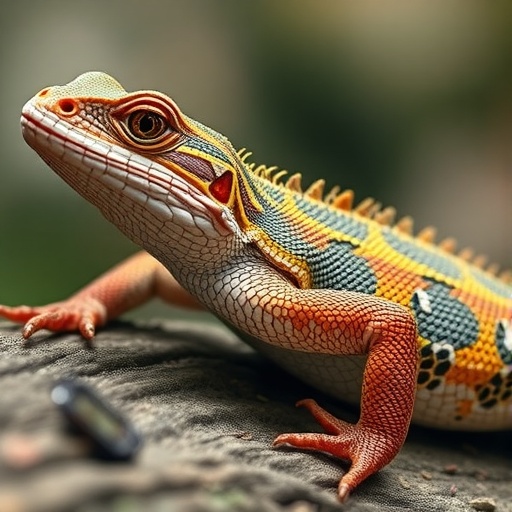A groundbreaking study led by Gabriel Henrique de Oliveira Caetano from Ben-Gurion University of the Negev and Université Paris-Saclay has introduced an innovative tool forecasting the future of vertebrate conservation. Published in PLOS Biology, this future-focused approach, the Proactive Conservation Index (PCI), reveals an unexpected shift in conservation priorities, spotlighting reptiles over amphibians in urgency for protection worldwide. As climate change and invasive species accelerate biodiversity loss, this research importantly bridges a critical gap left by existing conservation assessments that mainly consider historical data rather than imminent threats.
For decades, conservation biology has relied heavily on retrospective data—tracking past population declines and known habitats under current threats—to categorize species’ risk of extinction. However, this traditional outlook often neglects the evolving dynamics of environmental pressures exacerbated by global change. The PCI directly addresses this oversight by integrating projections of multiple future threats, such as climate-induced habitat shifts, ongoing land use transformations, and biological invasions. Its novel methodology evaluates species vulnerability through a multidimensional lens, incorporating life-history traits like body size, reproductive rates, and geographical distribution to estimate extinction risk more dynamically.
Applying this index globally, researchers analyzed an unprecedented breadth of land vertebrates—covering 33,560 species—to establish conservation priorities with future scenarios in mind. The PCI’s ranking system broadly aligns with the International Union for Conservation of Nature (IUCN) Red List, renowned for its extinction risk classifications. Yet, fascinatingly, PCI outcomes diverge on crucial points; it identifies reptiles as the vertebrate group most imperiled by upcoming environmental stressors, contrasting with the amphibian-dominant threat profile highlighted by the Red List. This discrepancy calls attention to species and regions potentially overlooked under current paradigms.
The underlying mechanics of the PCI enable it to quantify threats yet to fully manifest, thus offering a proactive strategy for conservation efforts. Species flagged as high priority by the PCI but not yet classified as endangered illuminate the biases inherent in relying solely on present-day assessments. Particularly, desolate arid zones, tropical islands renowned as biodiversity hotspots, and montane tropical forests emerge as crucial areas requiring immediate conservation focus. These regions are characterized by unique species particularly vulnerable to the impending compounded impacts of climate change and invasive organisms.
One compelling example highlighted by the study is the Hula painted frog (Latonia nigriventer) from northern Israel. Once thought extinct, this amphibian now scores extremely high on the PCI due to its restricted range and the severe threats projected from habitat disruption, invasive competitors, and climatic alterations. Its precarious situation epitomizes the necessity of preemptive conservation interventions before irreversible losses occur.
The technical sophistication of the PCI integrates ecological data with advanced modeling of future environmental scenarios, marking a pivotal shift toward more anticipatory biological safeguarding. By coupling species-specific vulnerability traits with anticipated threat trajectories, the index provides conservation managers and policymakers a refined tool for strategic resource allocation. This could lead to more impactful preservation efforts by focusing on species and habitats where intervention timing is critical for survival outcomes.
Beyond enhancing species-specific assessments, the PCI framework emphasizes the urgency of protecting ecosystems themselves. The study underscores that proactive conservation does not merely involve responding to crises but forecasting and mitigating them through predictive science. This paradigm shift fosters early action to maintain biodiversity and ecological resilience in an era of unprecedented environmental change.
Researchers from six countries, including France, Israel, the United States, India, the United Kingdom, and Australia, collaborated to develop and validate this index. Their cross-continental expertise ensured a globally applicable model capable of informing multinational conservation policy frameworks. Moreover, the study’s open-access publication ensures unrestricted availability of PCI methodologies and findings, supporting transparency and broad scientific application.
Importantly, the PCI complements rather than replaces existing conservation tools, providing an additional, future-oriented perspective on threat prioritization. Its capacity to highlight understudied or data-deficient species is vital, as many elusive taxa currently lack comprehensive risk assessments yet are exposed to accelerating environmental changes. By identifying such species early, the PCI empowers conservationists to preempt declines rather than reacting post-decline.
Funding from institutions such as the Jacob Blaustein Center for Scientific Cooperation and the Israeli Science Foundation backed this research, which was conducted free of sponsor influence on design or data interpretation. This independence underscores the academic rigor and credibility underpinning the PCI tool’s development and advocated use.
The study’s authors strongly advocate for embracing forward-looking conservation frameworks like the PCI to bolster biodiversity retention globally. As they note, the lag between threat onset and conservation response risks irreversible losses unless prediction and proactive intervention become standard practice. The PCI stands poised to be a transformative asset in shaping the future of global wildlife conservation.
To explore the full research and methodology detailed in this pioneering study, interested readers can access the paper freely via PLOS Biology at: https://plos.io/4nGIiQa. This accessible resource invites global collaboration toward refining and applying the PCI for safeguarding Earth’s vertebrate diversity amid tumultuous environmental change.
Subject of Research: Animals
Article Title: The future-focused Proactive Conservation Index highlights unrecognized global priorities for vertebrate conservation
News Publication Date: October 21, 2025
Web References: https://plos.io/4nGIiQa, http://dx.doi.org/10.1371/journal.pbio.3003422
References: de Oliveira Caetano GH, Murali G, Pincheira-Donoso D, Vardi R, Greenspoon L, Meiri S, et al. (2025) The future-focused Proactive Conservation Index highlights unrecognized global priorities for vertebrate conservation. PLoS Biol 23(10): e3003422.
Image Credits: Credit: Uri Roll (CC-BY 4.0)
Keywords: Proactive Conservation Index, PCI, vertebrate conservation, reptiles, amphibians, climate change, biodiversity, extinction risk, IUCN Red List, invasive species, habitat loss, conservation prioritization, ecological forecasting




